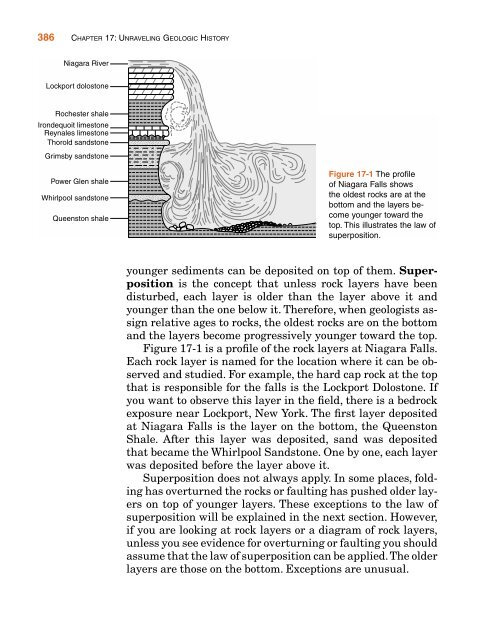Chapter 17 Unraveling Geologic History
Chapter 17 Unraveling Geologic History
Chapter 17 Unraveling Geologic History
Create successful ePaper yourself
Turn your PDF publications into a flip-book with our unique Google optimized e-Paper software.
386 CHAPTER <strong>17</strong>: UNRAVELING GEOLOGIC HISTORY<br />
Niagara River<br />
Lockport dolostone<br />
Rochester shale<br />
Irondequoit limestone<br />
Reynales limestone<br />
Thorold sandstone<br />
Grimsby sandstone<br />
Power Glen shale<br />
Whirlpool sandstone<br />
Queenston shale<br />
Figure <strong>17</strong>-1 The profile<br />
of Niagara Falls shows<br />
the oldest rocks are at the<br />
bottom and the layers become<br />
younger toward the<br />
top. This illustrates the law of<br />
superposition.<br />
younger sediments can be deposited on top of them. Superposition<br />
is the concept that unless rock layers have been<br />
disturbed, each layer is older than the layer above it and<br />
younger than the one below it. Therefore, when geologists assign<br />
relative ages to rocks, the oldest rocks are on the bottom<br />
and the layers become progressively younger toward the top.<br />
Figure <strong>17</strong>-1 is a profile of the rock layers at Niagara Falls.<br />
Each rock layer is named for the location where it can be observed<br />
and studied. For example, the hard cap rock at the top<br />
that is responsible for the falls is the Lockport Dolostone. If<br />
you want to observe this layer in the field, there is a bedrock<br />
exposure near Lockport, New York. The first layer deposited<br />
at Niagara Falls is the layer on the bottom, the Queenston<br />
Shale. After this layer was deposited, sand was deposited<br />
that became the Whirlpool Sandstone. One by one, each layer<br />
was deposited before the layer above it.<br />
Superposition does not always apply. In some places, folding<br />
has overturned the rocks or faulting has pushed older layers<br />
on top of younger layers. These exceptions to the law of<br />
superposition will be explained in the next section. However,<br />
if you are looking at rock layers or a diagram of rock layers,<br />
unless you see evidence for overturning or faulting you should<br />
assume that the law of superposition can be applied.The older<br />
layers are those on the bottom. Exceptions are unusual.
















